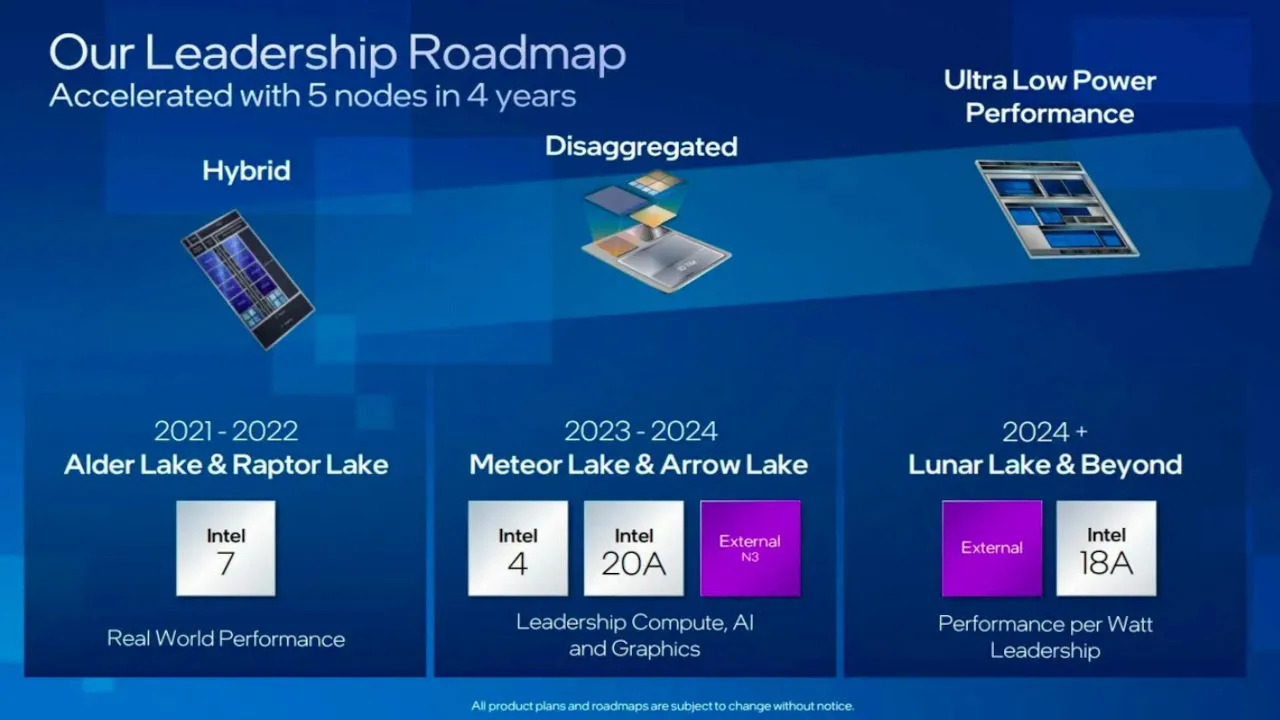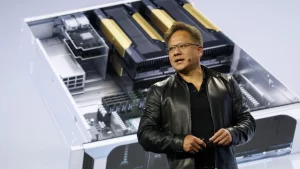Introduction
Intel is experiencing a renaissance period under Pat Gelsinger. Recently, it has revealed its foundry roadmap until 2027, unveiling a whole new line of Intel’s CPU Naming. It introduced Alder Lake in 2021, Meteor Lake in 2023, and Arrow Lake is expected to release in 2024, with Lunar and Panther Lakes in the lineup. However, Intel also has a branding of Intel Core i5/i7/i9 for its CPUs. What is the difference between the two nomenclatures?
Follow us on Linkedin for everything around Semiconductors & AI
Code Name and Brand Names: Core i5/i7/i9
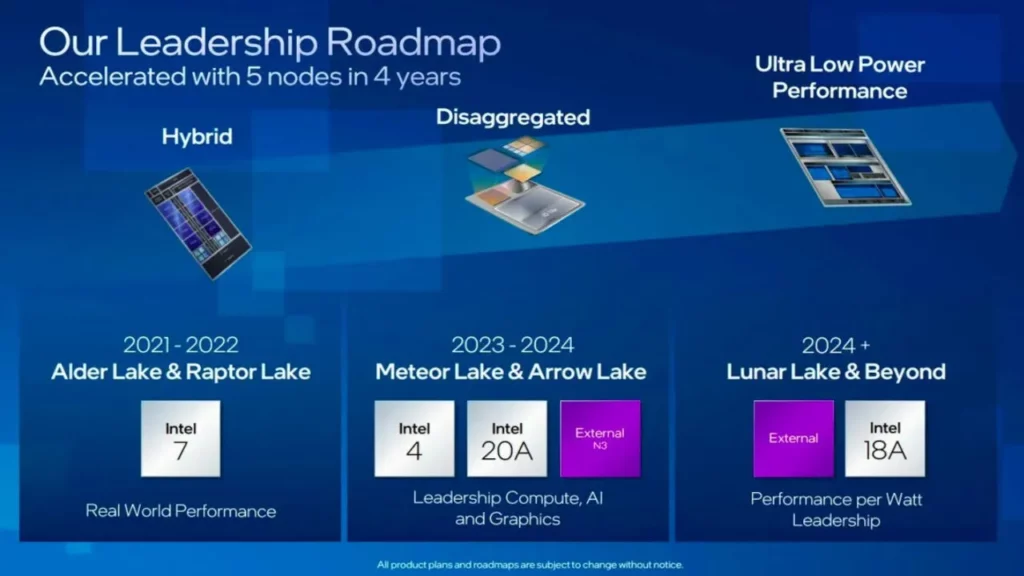
First and foremost, it is important to understand that Intel uses code names and brand names for its CPU releases. While code names identify the generation and process node of the CPU, brand names are the ones seen on boxes (Core i5/i7/i9).
Intel has released its nomenclature for its foundry node identification as Alder Lake, Meteor Lake, Lunar Lake, and so on. Each of these “lakes” comes with an advanced technology node and improved generational features. On the other hand, Intel also revamped its brand names by dropping the ‘i’ in Core i5/i7/i9.
The nomenclature puzzle with Intel CPUs comes from their dual naming system:
- Code Names (Meteor Lake, Arrow Lake): These are internal project names used during development and don’t directly tell you anything about the final product’s performance or features. They can be cryptic and change before release.
- Brand Names (Core i5/i7/i9): These are the consumer-facing names that appear on store shelves and packaging. They indicate the general performance tier (i3, i5, i7, i9) but not specific details like clock speed or core count.
This two-part system can be confusing because the code names don’t directly translate to brand names. You might see a news article about the upcoming “Meteor Lake” processor, but that doesn’t tell you if it will be a Core i5, i7, or something else entirely.
Let us explore Core i5/i7/i9 these releases and updates in an organized manner in the following paragraphs.
Intel Alder Lake
Process node – Intel 7 process technology (10nm)
Release – Late 2021
Alder Lake represents the 12th generation of Intel Core processors, introduced in late 2021. It was Intel’s first foray into a performance hybrid architecture. It is combining high-performance cores (P-cores) with high-efficiency cores (E-cores) on a single chip. This design aimed to optimize both power and performance, with the P-cores handling demanding tasks and the E-cores taking on background activities.
Intel’s Alder Lake brought the company back from what had been a slow erosion of its leadership position in our CPU benchmarks rankings as AMD relentlessly iterated on its Ryzen processor lineup. These chips were fabricated using intel’s 10nm process, now re-named as ‘Intel 7’.
Intel Raptor Lake
Process node – Intel 7 process technology (10nm)
Release – Oct 2022
Intel’s 13th-Gen Raptor Lake processors will bring more cores, more connectivity, a revamped core architecture, support for PCIe 5.0 SSDs, and even an officially verified 6.0 GHz peak boost clock to bear. Released in October 2022, the Raptor Lake had a 15% gain in single-threaded performance and a 41% gain in multi-threaded compared to Alder Lake, and an overall 40% performance scaling.
Intel Meteor Lake
Process node – Intel 4 process technology (7nm)
Release – Late 2023
Meteor Lake is the codename for Intel’s 14th generation, which debuted in late 2023. These processors are the first to utilize a chiplet architecture, where different components of the CPU are manufactured separately and then assembled together. Meteor Lake CPUs feature Redwood Cove P-cores and Crestmont E-cores, offering improved performance and efficiency over their predecessors.
Meteor lake processors are the first intel CPUs to integrate built in NPU for AI workloads and a tiled GPU architecture for enhanced graphics performance.
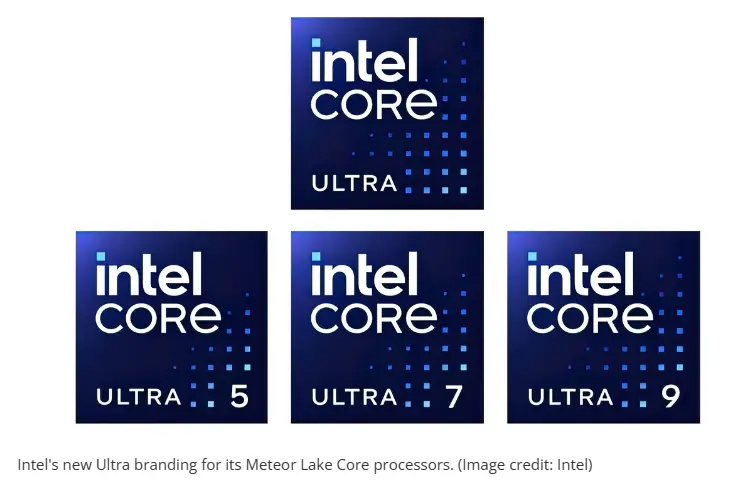
One of the most significant changes for Intel involves new names for its game-changing Meteor Lake processors, including dropping the useless ‘i’ from Core CPU labels. It’s part of an effort to reduce redundancy in naming its hardware. Thus, from Meteor Lake onwards Intel would release CPUs in the brand name of Intel Core 5 or Intel Core 5 Ultra.
Core Ultra could be the highest-core count version of a given chip (such as Meteor Lake), while Core denotes a model with the same architecture but fewer cores.
Read more AMD vs Intel: Which CPU Reigns Supreme in 2024? – techovedas
Intel Arrow Lake
Process node – Intel 20A (CPU Tile) / TSMC N3 (GPU Tile)
Release – Anticipated end of 2024
Unlike Meteor Lake and Lunar Lake, Arrow Lake processors serve both laptop and desktop platforms.
Arrow Lake, expected to debut towards the end of 2024, is set to be the 15th generation of Intel processors. Arrow Lake continues the chiplet design philosophy and is anticipated to bring further enhancements in AI performance and graphics capabilities. It’s reported that Arrow Lake will introduce new core architectures, Lion Cove for P-cores and Skymont for E-cores, and will be built on a new socket design, potentially requiring new motherboards.
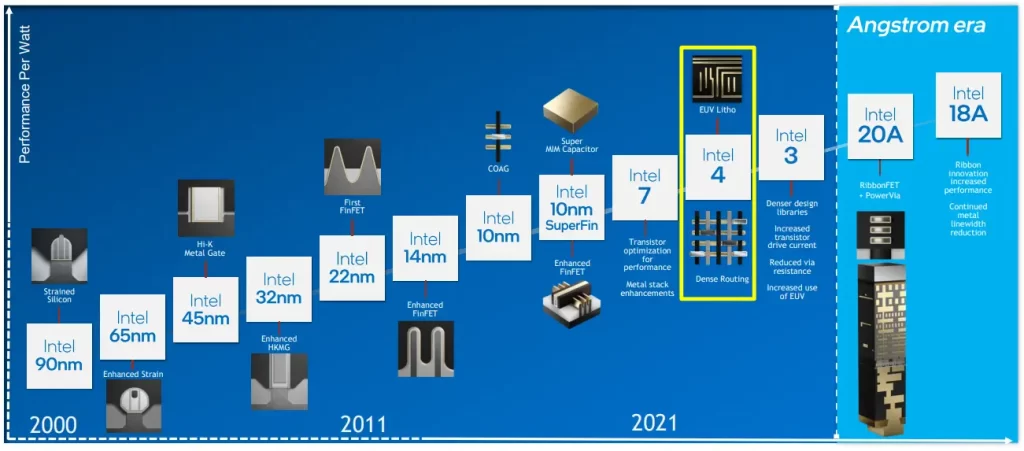
Intel 20A (or 20-angstrom, or 2 nm) node introduces gates-all-around (GAA) RibbonFET transistors with PowerVIAs.
Read more 20% Better Performance: 5 Things We are Expecting from Intel 15th-Gen Arrow Lake – techovedas
Intel Lunar Lake
Process node – Intel 18A CPU tile / TSMC N3B (GPU Tile)
Release – 2025 expected
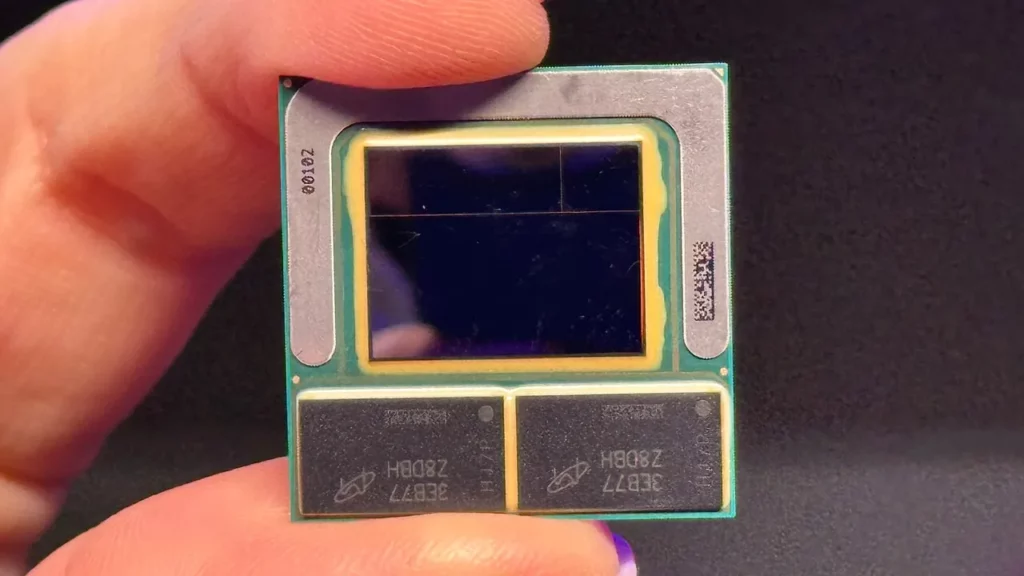
Lunar Lake photographed with Memory on Package
Intel unveiled the inaugural Lunar Lake processor at CES 2024, featuring an integrated memory on package design. The processor adopts a 4+4 core configuration and is coupled with LPDDR5X 8533 memory, boasting higher speed than the previous Meteor Lake. The memory source appears to be Micron, as revealed by a significant leak last year.
It is expected to follow Arrow Lake, with a focus on low-power architecture and significant IPC (instructions per cycle) improvements. It’s expected to offer three times more AI performance on both the GPU and NPU compared to Meteor Lake.
Additionally, Lunar Lake will likely use Intel’s 18A node for the compute chiplet, marking a significant step in manufacturing technology.
Panther Lake
Gelsinger acknowledged the existence of Panther Lake, confirming earlier speculations. With significant development advancements, preliminary production of Panther Lake is slated for Q1 2024, with an official launch in 2025.Additionally,manufactured through the 18A process, Panther Lake marks the fifth manufacturing process Intel has introduced in four years, succeeding Intel 7, 4, 3, and 20A.
While intricate details remain undisclosed, Panther Lake aims to serve both desktop and mobile sectors, adopting the LGA-1851 socket, consistent with Arrow Lake’s desktop designs.
Conclusion
As Intel navigates from the established FinFET to the pioneering RibbonFET and PowerVia technologies, it envisions a transformative impact on power delivery mechanisms and overall chip architecture. As the semiconductor industry watches, Intel’s ambition to execute “five nodes in four years” could very well reshape the future of computing, marking a new era of innovation and performance leadership.
Read more Intel Mobile Chips to Use 2 nm node from TSMC by 2026: Report – techovedas

